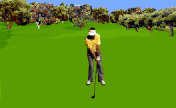The short game is often ignored and people concentrate and practice the long game harder. The short game is hard because of the technicalities involved and takes up much more time to master. However, with these great tips, you will have no problem in stepping up a notch and becoming an expert golfer.
There are two type of pitches involved in the short game. These pitches depend on the distance that you are from the green. The further you are away from the pin the longer your swing will be. When you are around the fringe of the green that is when you will be chipping and that is outside of the scope of this article. In this article I will concentrate on pitches of 30 yards or less and those of 100 to 30 yards away.
You have taken the big swing and landed the ball within 100 yards of the hole. Now you need to take a swing at the ball. Here are the surefire tips for the short game that will help you get the ball closer to the pin.
Inside 30 Yards
For this pitch you want to assume a neutral grip. What I mean by a neutral grip is that when you look down at your hands as they grip the club you should be able to see two knuckles of the left hand (right hand for the left hander's). You should also be griping the club down at the end of the grip and close to the shaft.
For your stance you want to place your feet a little less than shoulder width apart and play the ball in the middle of your stance. Your hands should be a little ahead of the ball and you left (right for lefties) should be slightly pointed out about 25 to 35 degrees and the other foot about 10 to 15 degrees.
Your knees need to be flexed as you address the ball and your knees, hips and should should be perpendicular to the target. Your weight should be about 60 percent towards the left foot for right-handers and the opposite for the lefthanders.
For the standard pitch shot you want to bring the club back by cocking the wrists until the shaft of the club is parallel to the ground. Then you want to follow through until the shaft of the club is perpendicular to the ground. Remember the follow trough is important as it helps to make sure that the club head is acceleration through the ball.
The clubs you will use to this shot will vary with the circumstances. If you want a high pitch then you would use a wedge or another lofted club. For a low pitch you may want to choose a 7, 8, or 9 iron. You have to remember that the lower the pitch the more run you will get when the ball hits the green.
Inside 100 Yards
For this shot you will more than likely be choosing a wedge for a club. This club is ideal for this type of pitch. Wedges come in various degrees of loft so you need to practice to see which wedge you feel comfortable with for the distance you are at.
For this shot you are going to set up much like you did for the pitch shot 30 yards and under with a few exceptions. In order to get the required distance you are going to have to turn your body further and swing further. To accomplish this you should widen your stance to about your shoulder width and grip your club in the normal manner, more up towards the end of the grip. Your weight distribution should be equal or slightly to the back foot.
Once you have establish the address position you will simply need to turn and swing back until your arms are parallel to the ground and the club is perpendicular to the ground. From the backswing you want to turn and swing through in unison until the finish where you will find almost all of your weight on the front foot and the club above your head and parallel to the ground.
I feel that if you follow these tips on the short game that you will be able to reduce the number of strokes on your score card.
Visit http://www.ultimateseniorgolfer.com where you will find great tips and information for the senior golfer.




